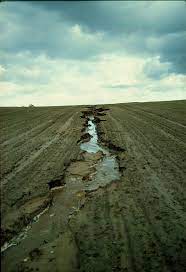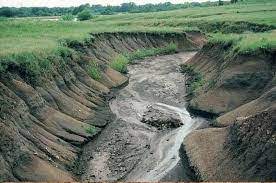The major process that robs soil of its fertility quickly is soil erosion. Therefore, we are going to see what soil erosion is, its types and its agents. We will also attempt to indicate the factors of soil erosion.
We have been talking about different aspects of soil in some of our previous articles. The aspect we start considering in this article is so important to mankind. Do you remember that soil is regarded as a resource? And that when it is injudiciously used, soil is robbed of its fertility.
What is Soil Erosion?
Soil erosion could be defined as the detachment and removal of the topsoil either partially or completely by water, wind and ice especially by water and wind.
Types of Erosion
There are two main types of erosion. They are:
Normal geological erosion and
Accelerated soil erosion.
Normal geological erosion is widespread. It occurs whenever there is a flow of energy and matter on the earth’s surface. As it is very slow, it is not injurious to the soil cover of the world. More often than not, its rate is slower than, or at worst on a par with the rate of soil formation and renewal. Its effect is therefore rarely noticeable.
Read Also : Traditional Soil Classification Systems
Accelerated soil erosion is usually associated with man’s activities. As a result of its spectacular nature, it is the one that attracts man’s attention. Its side-effects include the physical loss of the soil constituents leading to severe economic loss as a result of reduced crop yield or total crop failure.
Accelerated soil erosion may also result in a total loss of farmlands to gully erosion. It may also increase sediment yield and pollutants of streams, rivers, lakes and oater water bodies.
Agents and Forms of Erosion
The most common agents of erosion are water and wind. Ice is also recognized as an agent of erosion but not as effective as both water and wind.

It is important for you to know that soil erosion by water is known to be the most common. This is because it affects the largest parts of agricultural world. There are three forms of soil erosion by water. They include rills, sheets and gullies.
Rills are parallel shallow, narrow channels on bare hill-slopes. They are especially common where the subsoil is poorly permeable as to allow surface flow.
Sheet erosion occurs where turbulent unchanneled flow exerts more energy than soil cohesion can resist. The removal of soil in sheet erosion may not be very noticeable but it removes the topmost soil.
Gully is a channel cut so deeply into the underlying material. Gullying is a very serious form of soil erosion especially in agricultural areas. Gullies are very common in many parts of Anambra, Imo, Edo, Plateau, Kwara and Kaduna State, all in Nigeria.
Wind is principally an agent of sheet erosion, with very devastating results. Wind erosion occurs in wide, flat areas where winds blow strongly, where there are no wind-breaks and where the soil is dry and unprotected by plant cover.
Areas of semi-arid and arid continental plains are especially notable for wind erosion. It is, therefore, partly, if not entirely, a dry weather phenomenon.
Another very important point to note is that the degree of wind erosion is very largely related to wind strength. Wind velocity tends to be highest in wide, open, level areas, for there isnnothing to impede its progress. Furthermore, in areas subject to wind erosion, not only is the land denuded of its richest soil but any growing crops may be destroyed or serious damaged.
Physical Factors of Soil Erosion
There are two main factors responsible for accelerated soil erosion. These are physical and human factors. In this section we will consider the physical factors.
Physical factors of soil erosion are natural factors that could bring about soil erosion. They include the nature of the soil itself, the nature of the land surface or topography, climate and vegetation cover.
Nature of Soil:concerns such attributes as infiltration capacity, permeability and water holding capacity. In as much as all these are low erosion will take place once the land surface is disturbed.
Topographicfactorof soil erosion is exemplified by the type of slopes found in an area. Soil erosion on slopes tends to vary with both the degree and length of slope. Generally, the rate of soil loss increases with increase in slope angle and slope length.
It is to be noted that soil erosion rates differ on the slope form i.e. convex, concave and even. Concave slope form is the most susceptible form of slope to rapid soil erosion.
Climate influences soil erosion in two main ways. First, it dictates whether the erosive agent will be water, wind or ice. Secondly, climate regulates the intensity of soil erosion.
Vegetation cover usually protects the soil from being eroded but where vegetation covers non-existent or scarce, soil erosion is common. Vegetation cover disallows direct raindrop impact on the soil by reducing the quantity of rainfall that reaches the soil surface. It also improves soil structure and increases infiltration capacity of the soil. Roots of plants also make soil firm and stable.
Human Factors of Soil erosion
The human factor in soil erosion is depicted through man’s activities that include farming, grazing, mining, industrialization, urbanization and indeed, civil engineering constructions. All these activities disturb the delicate balance of terrestrial ecosystems that may induce accelerated soil erosion.
Agriculture is, perhaps, the most important cause of soil erosion, principally because of its widespread occurrence. Agriculture, particularly arable farming involves the removal, wholly or partly, of the original vegetation. Note, however, that the extent of soil erosion will depend on the system of cultivation, the intensity of cultivation and the types of crops grown.
Grazing of animals can also lead to soil erosion. The constant removal of vegetal cover by cattle, sheep and goats leads to the exposure of the land surface to the harsh effects of rainfall.
Mining activities render vast areas valueless for other land uses. These usually lead to land shortage resulting to pressure on the land, land exhaustion, and consequently excessive soil erosion. A very good example of this is provided by the Jos Plateau where tin and columbite ores have been mined for many decades.
Engineering Constructions also lead to erosion which may take the form of gully. Similarly, footpaths, roads, settlements and market places can cause accelerated soil erosion since all of them concentrate runoff which initiates channelized soil erosion after they have stripped the soil of its vegetation.
In conclusion, you can see that this article has opened your eyes to the fact that when soil, as a resource, is misused or mismanaged, erosion takes place. And do you remember the definition of soil erosion?
It is the detachment and removal of the topsoil. The types, agents and form of soil erosion are considered and it is observed that while water erosion is the most prevalent, wind erosion occurs in arid and semi-arid lands.
The worst form of soil erosion is the gully. It is important to note that certain factors are responsible for soil erosion. These are divided into physical and human factors.
Soil erosion has been defined as the detachment and removal of the topsoil either completely or partially. There are normal geological erosion which occurs but whose effect on soil removal is so negligible; and accelerated soil erosion whose effects are quite noticeable on the land surface.
The most common agents of soil erosion are water and wind but ice is also regarded as an important agent as well. Water erosion is of three main forms. They are rills, sheets and gullies.
Read Also : The Three (3) Major Soil Types of the World
Gullies are the most prominent, destructive and dangerous. In fact, their effects are the concerns, not only of the Local Government Areas in which they are found, but also of those the states, Federal Government and International Agencies.
Wind erosion is found mainly in arid and semi-arid areas of the world. Note that the extent of wind erosion is largely related to the strength of the wind.
A set of factors have been identified for bringing about accelerated soil erosion. They are divided into physical and human factors. Physical factors are natural including the nature of soil, the topography, climate and vegetation cover.
However, human factors result from activities on the land surface. These could include agriculture, grazing, mining and engineering constructions.

